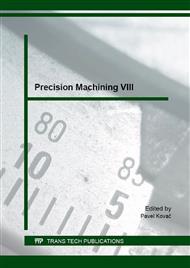[1]
R. Bauer, Obrabeni tezkoobrobitelnych materialu [online]. 2008 [cit. 2014-3-13]. Available at www: http: /www. mmspektrum. com/clanek/obrabeni-tezkoobrobitelnych-materialu. html.
Google Scholar
[2]
J. Brychta, R. Cep, M. Sadilek, L. Petrikovska, J. Novakova, Nové směry v progresivním obrábění, Ostrava: VŠB, 2007, 251 pp.
Google Scholar
[3]
P. Byrne Turning, milling and grinding processes. London, Arnold, (1996).
Google Scholar
[4]
A. Czan, M. Sajgalik, J. Holubjak, K. Kouril, Studying of Cutting Zone When Finishing Titanium Alloy by Application of Multifunction Measuring System. Manufacturing Technology, Vol. 13., No. 4, 2013, pp.428-431.
DOI: 10.21062/ujep/x.2013/a/1213-2489/mt/13/4/428
Google Scholar
[5]
F. Holesovsky, M. Novak, Grinding and its influence to ground surface durability. Proceedings of International Conference on Advances in Materials and Processing Technologies, Paris. Publisher: Amer INST Physics, Melville, NY, USA. (2010).
Google Scholar
[6]
INCONEL® alloy 718 (UNS N07718) [online]. 2007 [cit. 2014-3-13]. Available at www: http: /www. hpalloy. com/alloys/descriptions/INCONEL718. html.
Google Scholar
[7]
INCONEL® alloy 718, company informations, [online]. 2007 [cit. 2014-3-13]. Availavle et www: http: /www. specialmetals. com/documents/Inconel%20alloy%20718. pdf.
Google Scholar
[8]
J. Jersák, Vliv dynamickeho vyvazeni brousiciho kotouce na drsnost povrchu obrobenych soucasti, Strojirenska technologie, Vol. 17, No. 1, 2, 2012, pp.27-33.
Google Scholar
[9]
O. Jusko, Vyvoj a inovace brousicich nastroju. Strojirenská technologie. Vol. 15, No. 1, 2010, pp.17-22.
Google Scholar
[10]
D. Kalincova, Skúšanie mechanických vlastností materiálov - prehlad meracích metód a zariadení. Proceedings Zvysovani efektivnosti vzdelavacieho procesu prostrednictvom inovacnzch prostriedkov, TU vo Zvolene, Zvolen., SK, 2010, pp.13-26.
Google Scholar
[11]
K. Kocman, Optimalizace dokoncovacich operaci vyrobnich procesu, Strojirenska technologie, Vol. 17, No. 3, 2012, pp.164-169.
Google Scholar
[12]
K. Kouril, R. Cep, A. Janasek, A. Kriz, D. Stancekova, Surface integrity at reaming operation by MT3 head. Manufacturing Technology, Vol. 14, No. 2, 2014, pp.193-199.
DOI: 10.21062/ujep/x.2014/a/1213-2489/mt/14/2/193
Google Scholar
[13]
I. D. Marinescu et all, Handbook of Machining with Grinding wheels, Boca Raton, CRC Press, 2007, 592 pp.
Google Scholar
[14]
J. N. Maslov, Teorie brousení kovu. Praha: SNTL, 284 pp., (1979).
Google Scholar
[15]
M. Novak, Surface quality of hardened steels after grinding, Manufacturing Technology, Vol. 11, No. 11, UJEP, Usti nad Labem, 2011, pp.55-59.
DOI: 10.21062/ujep/x.2011/a/1213-2489/mt/11/1/55
Google Scholar
[16]
M. Novak, Surfaces with high precision of roughness after grinding. Manufacturing Technology, Vol. 12, No. 13, 2012, pp.66-70.
DOI: 10.21062/ujep/x.2012/a/1213-2489/mt/12/1/66
Google Scholar
[17]
M. Novak, F. Holešovský, Studium integrity brouseného povrchu [online]. [cit. 2014-2-28]. Available at www: http: /www. fvt. tuke. sk/journal/pdf08/2-str-11-13. pdf.
Google Scholar
[18]
N. Novak, H. Kasuga, H. Ohmori, Differences at the Surface Roughness by the ELID and Grinding Technology. Manufacturing Technology, Vol. 13, No. 2, 2013, pp.210-215.
DOI: 10.21062/ujep/x.2013/a/1213-2489/mt/13/2/210
Google Scholar
[19]
M. Novak, Studium jakosti brouseneho povrchu kalenych oceli, cast I. – drsnost povrchu, Strojirenska technologie, Vol. 16, No. 6, 2011, pp.26-33.
Google Scholar
[20]
K. Osicka: Prumerna aritmeticka uchylka drsnosti povrchu - statisticke vyhodnoceni plochy. Strojirenska technologie. Vol. 14, No. 1. 2009, pp.30-32.
Google Scholar
[21]
L. Rokyta, I. Lukovics, Vyzkum vlivu pomeru brusiv na jakost povrchu pri brouseni. Strojirenska technologie, Vol. 17, No. 1, 2, 2012, pp.93-95.
Google Scholar
[22]
M. Tavodova, The surface quality of materials after cutting by abrasive water jet evaluated by selected methods. Manufacturing technology, Vol. 13, No. 2, 2013, pp.236-241.
DOI: 10.21062/ujep/x.2013/a/1213-2489/mt/13/2/236
Google Scholar
[23]
J. Valicek, J. Rusnak, M. Müller, P. Hrabě, M. Kadnar, S. Hloch, M. Kusnerova, Geometricke aspekty drsnosti povrchu klasickych a netradicnich technologii. Jemna mechanika a optika, Vol. 53, No. 9, 2008, pp.249-253.
Google Scholar


